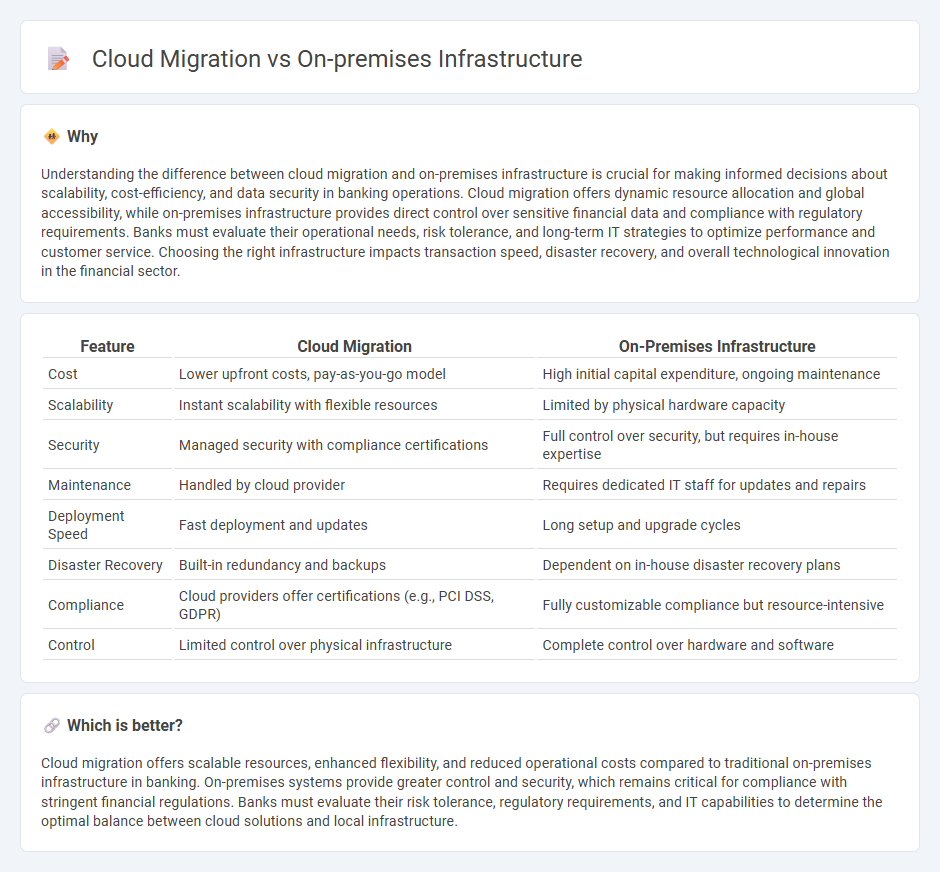
Cloud migration offers scalable, cost-efficient solutions for banking infrastructure, enabling real-time data access and enhanced security through advanced encryption protocols. On-premises infrastructure provides direct control over hardware and compliance, often preferred for sensitive financial data requiring stringent regulatory adherence. Explore the benefits and challenges of each approach to determine the best fit for your banking institution's technology strategy.
Why it is important
Understanding the difference between cloud migration and on-premises infrastructure is crucial for making informed decisions about scalability, cost-efficiency, and data security in banking operations. Cloud migration offers dynamic resource allocation and global accessibility, while on-premises infrastructure provides direct control over sensitive financial data and compliance with regulatory requirements. Banks must evaluate their operational needs, risk tolerance, and long-term IT strategies to optimize performance and customer service. Choosing the right infrastructure impacts transaction speed, disaster recovery, and overall technological innovation in the financial sector.
Comparison Table
| Feature | Cloud Migration | On-Premises Infrastructure |
|---|---|---|
| Cost | Lower upfront costs, pay-as-you-go model | High initial capital expenditure, ongoing maintenance |
| Scalability | Instant scalability with flexible resources | Limited by physical hardware capacity |
| Security | Managed security with compliance certifications | Full control over security, but requires in-house expertise |
| Maintenance | Handled by cloud provider | Requires dedicated IT staff for updates and repairs |
| Deployment Speed | Fast deployment and updates | Long setup and upgrade cycles |
| Disaster Recovery | Built-in redundancy and backups | Dependent on in-house disaster recovery plans |
| Compliance | Cloud providers offer certifications (e.g., PCI DSS, GDPR) | Fully customizable compliance but resource-intensive |
| Control | Limited control over physical infrastructure | Complete control over hardware and software |
Which is better?
Cloud migration offers scalable resources, enhanced flexibility, and reduced operational costs compared to traditional on-premises infrastructure in banking. On-premises systems provide greater control and security, which remains critical for compliance with stringent financial regulations. Banks must evaluate their risk tolerance, regulatory requirements, and IT capabilities to determine the optimal balance between cloud solutions and local infrastructure.
Connection
Cloud migration enhances banking operations by enabling seamless integration with existing on-premises infrastructure, facilitating hybrid cloud environments that optimize data storage, security, and compliance. Banks leverage cloud services to scale resources dynamically while maintaining critical workloads on-premises for regulatory adherence and low-latency processing. This interconnected approach improves operational efficiency, disaster recovery, and innovation in digital banking services.
Key Terms
Data Security
On-premises infrastructure offers direct control over data security with physical access restriction and customizable security protocols, minimizing exposure to external threats. Cloud migration introduces advanced encryption, automated compliance monitoring, and scalable access controls, yet requires trust in third-party providers for data protection. Explore detailed comparisons and best practices to secure your data during cloud transition.
Scalability
On-premises infrastructure offers limited scalability due to physical hardware constraints, requiring significant capital investment and time to expand resources. Cloud migration enables dynamic scalability, allowing businesses to instantly adjust computing power and storage based on demand, reducing downtime and operational costs. Explore how cloud scalability can transform your organization's agility and growth potential.
Compliance
On-premises infrastructure offers direct control over data security and regulatory compliance, enabling organizations to tailor policies to meet specific industry standards such as GDPR, HIPAA, or PCI-DSS. Cloud migration introduces shared responsibility models where compliance relies on both the cloud service provider's certifications and the client's active management of configurations and access controls. Explore detailed strategies to ensure compliance throughout the cloud migration journey.
Source and External Links
Cloud vs. On-Premises: Exploring Key Differences - This page discusses on-premises infrastructure as a traditional method of managing computing resources entirely within an organization's physical site, offering control over hardware and software but requiring higher upfront costs and ongoing maintenance.
On premises vs. cloud pros and cons - This article highlights the advantages of on-premises infrastructure, including total control, predictable costs, enhanced security, and performance efficiency, though it also requires hands-on hardware maintenance.
What is on-premises? - This webpage explains on-premises infrastructure as computing resources located and operated within an organization, offering complete control, data sovereignty, and performance optimization, often used for sensitive data processing and high-performance computing.
 dowidth.com
dowidth.com